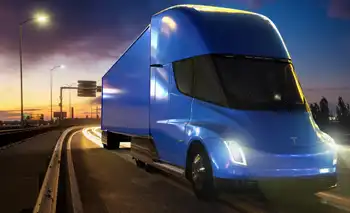Canada’s Clean Energy Sector Growth

Protective Relay Training - Basic
Our customized live online or in‑person group training can be delivered to your staff at your location.

- Live Online
- 12 hours Instructor-led
- Group Training Available
Canada’s clean energy sector is expanding as Indigenous communities lead electricity transmission projects, drive sustainable growth, and strengthen energy independence through renewable power, community ownership, and grid connections across remote and regional areas of Canada.
What is Canada’s Clean Energy Sector?
Canada’s clean energy sector encompasses industries and initiatives that generate, transmit, and manage low-carbon electricity to meet the country's national climate goals. It emphasizes Indigenous participation, renewable innovation, and equitable economic growth.
✅ Expands renewable electricity generation and transmission
✅ Builds Indigenous-led ownership and partnerships
✅ Reduces emissions through sustainable energy transition
Canada’s clean energy sector is entering a pivotal era of transformation, with Indigenous communities emerging as leading partners in expanding electricity transmission and renewable infrastructure, including grid modernization projects that are underway nationwide. These communities are not only driving projects that connect remote regions to the grid but also redefining what energy leadership and equity look like in Canada.
At a recent webinar co-hosted by the Canadian Climate Institute and the Indigenous Power Coalition, panellists discussed the growing wave of Indigenous-led electricity transmission projects and the policies needed to strengthen Indigenous participation. The event, moderated by Frank Busch, featured Margaret Kenequanash, CEO of Wataynikaneyap Power; Kahsennenhawe Sky-Deer, Grand Chief of the Mohawk Council of Kahnawà:ke; and Blaise Fontaine, Co-Founder of ProACTIVE Planning Inc. and Indigenous Power Coalition.
The discussion comes at a crucial moment for Canada’s clean energy transition. As the country races to meet its climate commitments and zero-emissions electricity by 2035 targets, demand for clean power is rising rapidly. Historically, energy development in Canada occurred on Indigenous lands without consent or fair participation, but today, Indigenous communities collectively represent the largest clean energy asset owners outside Crown and private utilities.
“There is a genuine appetite for Indigenous communities to not just own transmission projects but to also lead,” said Fontaine. He noted that Indigenous communities are increasingly setting the terms of engagement, selecting partners, and shaping projects in line with their cultural and environmental values.
One of the strongest examples of this transformation is the Wataynikaneyap (Watay) Power Project in northern Ontario, a 1,800-kilometre transmission line connecting 17 remote First Nations communities to the provincial grid. “Communities must fully understand what they are getting into, since it is their homelands that will be impacted,” said Kenequanash. She emphasized that the project’s success came from five years of inter-community meetings to agree on shared principles before any external engagement.
The panel also highlighted the Hertel–New York Interconnection Line, co-owned by Hydro-Québec and the Mohawk Council of Kahnawà:ke, as another milestone in Indigenous energy leadership. Sky-Deer noted that the project’s co-ownership model required Quebec’s National Assembly to pass Bill 13, a first-of-its-kind legal framework. “That was a breakthrough,” she said, “but it also shows that true partnership still depends on one-off exceptions rather than standard policy.”
Panellists agreed that Canada’s regulatory systems have not kept pace with Indigenous leadership. Fontaine called on governments to “think outside the box to avoid staying stuck in the status quo,” emphasizing the need for enabling policies that align with an electric, connected and clean vision for Canada while making Indigenous-led ownership the norm rather than the exception.
Financial readiness is another key factor driving Indigenous participation. Communities are now accessing capital through partnerships with financial institutions and government loan programs, and growing evidence that a 2035 zero-emissions grid is practical and profitable is strengthening investor confidence. The collaboration between the Mohawk Council of Kahnawà:ke and the Caisse de dépôt et placement du Québec exemplifies tailored financing and long-term investment that supports community ownership and sustainable growth.
True equity, however, goes beyond financial participation. “It’s not just about having a percentage stake,” Fontaine explained. “True equity means meaningful decision-making power and control.” Indigenous leaders are insisting on co-governance structures that align with their worldviews, prioritizing environmental protection, cultural respect, and intergenerational stewardship.
The benefits of this approach extend far beyond project economics. Communities involved in ownership experience tangible local benefits, including employment and training opportunities, as well as new investments in education and culture. Hydro-Québec’s $10 million contribution to the Kahnawà:ke Cultural Arts Center is one example of how partnerships can support cultural renewal and community development.
As Canada looks to build east–west electricity interties and expand renewable energy generation, including solar where Canada has lagged in deployment nationwide, Indigenous leadership is becoming increasingly central to national energy policy. Fontaine noted that this shift offers “even greater opportunities for Indigenous-led transmission as Canada connects its provinces rather than just exporting power south.”
In particular, Alberta's energy profile highlights both rapid growth in renewables and ongoing fossil fuel strength, informing intertie planning and market design.
On the National Truth and Reconciliation Day, panellists urged reflection on both the barriers that remain and the opportunities ahead. Indigenous leadership in Canada’s clean energy sector is proving that reconciliation can take tangible form, through ownership, partnership, and shared prosperity.
This transformation represents more than an energy transition; it’s a rebalancing of power, respect, and responsibility, carried out “in a good way,” as the panellists emphasized, and essential to building a clean, inclusive energy future for all Canadians while strengthening the global electricity market position of the country.
Related Articles















